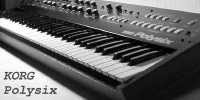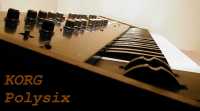-Above photo from aPolysix advertisement courtesy of Johan Dalsrud
-Photos below are from Johan Dalsrud's collection
This synthesizer was released in 1981, and features six voice polyphony (as if anyone didn't guess that by its name), a 5 octave keyboard (61 keys, not touch sensitive), 32 programmable memory slots, 1 VCO per voice, 24 dB/octave VCF's & normal ADSR controlled VCA, a cool arpeggiator and a quite useful effect section. The VCO is square, PW or PWM with controls for octave(pitch) and speed. The VCF has controls for cutoff, resonance, EG (envelope generator) intensity and keyboard tracking.

The Polysix is full of knobs and buttons, that gives you instant access to all of the parameters and effects. It was the last Korg to have that, since its successor the Poly-61 introduced DCO's and digital programming. No more hands on knobs when playing, and more tedious programming. The Polysix have 3 different play modes. Normal - as any polyphonic synth, Unison - makes all 6 voices play the same note, and Chord - memorizes a played chord and transposes this when a key in the desired pitch is played.
It also has a sub oscillator, like many single VCO synths, that adds depth to the sound. They say it sounds fatter and warmer then the 2 DCO Poly-61, although this synth has twice the number of oscillators.
The Polysix have SSM chips for its filters and envelopes, and some say this explains its warm sound. It also has a special self-tuning function. In unison mode the six voices are adjusted a little bit out of tune from each other, giving you a real fat monophonic lead sound. There are separate wheels for pitch bend and modulation. The Polysix was one of the last Korgs to have this instead of the (in my opinion) cheaper joystick.
The Polysix came out in the same time as the Mono/Poly, and these two synths have a lot in common. They have the same layout on many controls, and the design with the dark blue/black color and fake wood chassis give them a sturdy feel.

Both the Polysix and the Mono/Poly share the effect section and arpeggiator. The latter can go up or down or both. It has a speed of 0,2 up to 20 Hz. Useful for really fast runs. They also share the Korg tape input, for saving or loading banks of new sound.
The Polysix was reasonably priced at the time and sold well. I think its last list price was about $ 1100. It can be compared to the Roland Juno range with features, price and sound.
There are a couple of things one should look out for though. Almost every Polysix has a battery leakage problem. This is due to its rechargeable NiCd that, after many years, tends to leak and slowly eat up the circuitboard traces below it. If some Polysixes are behaving strangely, this is probably the cause. Also some keys tends to have trouble with their 'rubber' contacts. But this turned out fine with my Polysix with a little cleanup and a light rubbing. It's easy to fix.
-Submitted by Johan Dalsrud, Norway

